Simulated Changes in Seasonal and Low Flows with Climate Change for Irish Catchments
Abstract
:1. Introduction
2. Materials and Methods
2.1. Hydroclimatic Indices and Catchments
2.2. Climate Models and Bias Correction
2.3. Hydrological Models
2.3.1. The GR4J Model
2.3.2. SMART Model
2.4. Hydrological Model Calibration and Evaluation
3. Results
3.1. Bias Correction
3.2. Hydrological Model Performance
3.3. Projected Changes in Seasonal Flows
3.3.1. SSP126 Sustainable Future
3.3.2. SSP370 Rocky Road
3.3.3. SSP585 Fossil Fuel Intensive
3.4. Projected Changes in Low Flows
3.5. Avoided Impacts from Mitigation
3.6. ESMs with High Climate Sensitivity
4. Discussion
5. Conclusions
Supplementary Materials
Author Contributions
Funding
Data Availability Statement
Acknowledgments
Conflicts of Interest
References
- Kay, A.L. Simulation of river flow in Britain under climate change: Baseline performance and future seasonal changes. Hydrol. Process. 2021, 35, e14137. [Google Scholar] [CrossRef]
- Middelkoop, H.; Daamen, K.; Gellens, D.; Grabs, W.; Kwadijk, J.C.; Lang, H.; Parmet, B.W.; Schädler, B.; Schulla, J.; Wilke, K. Impact of climate change on hydrological regimes and water resources management in the Rhine basin. Clim. Chang. 2001, 49, 105–128. [Google Scholar] [CrossRef]
- Qin, P.; Xu, H.; Liu, M.; Du, L.; Xiao, C.; Liu, L.; Tarroja, B. Climate change impacts on Three Gorges Reservoir impoundment and hydropower generation. J. Hydrol. 2020, 580, 123922. [Google Scholar] [CrossRef]
- Whitehead, P.G.; Wilby, R.L.; Battarbee, R.W.; Kernan, M.; Wade, A.J. A review of the potential impacts of climate change on surface water quality. Hydrol. Sci. J. 2009, 54, 101–123. [Google Scholar] [CrossRef]
- Vetter, T.; Reinhardt, J.; Flörke, M.; Van Griensven, A.; Hattermann, F.; Huang, S.; Koch, H.; Pechlivanidis, I.G.; Plötner, S.; Seidou, O.; et al. Evaluation of sources of uncertainty in projected hydrological changes under climate change in 12 large-scale river basins. Clim. Chang. 2017, 141, 419–433. [Google Scholar] [CrossRef]
- Falzoi, S.; Gleeson, E.; Lambkin, K.; Zimmermann, J.; Marwaha, R.; O’Hara, R.; Green, S.; Fratianni, S. Analysis of the severe drought in Ireland in 2018. Weather 2019, 74, 368–373. [Google Scholar] [CrossRef] [Green Version]
- Kelly-Quinn, M.; Blacklocke, S.; Bruen, M.; Earle, R.; O’Neill, E.; O’Sullivan, J.; Purcell, P. Dublin Ireland: A city addressing challenging water supply, management, and governance issues. Ecol. Soc. 2014, 19, 10. [Google Scholar] [CrossRef] [Green Version]
- Broderick, C.; Murphy, C.; Wilby, R.L.; Matthews, T.; Prudhomme, C.; Adamson, M. Using a scenario-neutral framework to avoid potential maladaptation to future flood risk. Water Resour. Res. 2019, 55, 1079–1104. [Google Scholar] [CrossRef]
- Meresa, H.; Murphy, C.; Fealy, R.; Golian, S. Uncertainties and their interaction in flood hazard assessment with climate change. Hydrol. Earth Syst. Sci. 2021, 25, 5237–5257. [Google Scholar] [CrossRef]
- Charlton, R.; Fealy, R.; Moore, S.; Sweeney, J.; Murphy, C. Assessing the impact of climate change on water supply and flood hazard in Ireland using statistical downscaling and hydrological modelling techniques. Clim. Chang. 2006, 74, 475–491. [Google Scholar] [CrossRef]
- Steele-Dunne, S.; Lynch, P.; McGrath, R.; Semmler, T.; Wang, S.; Hanafin, J.; Nolan, P. The impacts of climate change on hydrology in Ireland. J. Hydrol. 2008, 356, 28–45. [Google Scholar] [CrossRef]
- O’Neill, B.C.; Tebaldi, C.; Vuuren, D.P.V.; Eyring, V.; Friedlingstein, P.; Hurtt, G.; Knutti, R.; Kriegler, E.; Lamarque, J.F.; Lowe, J.; et al. The scenario model intercomparison project (ScenarioMIP) for CMIP6. Geosci. Model Dev. 2016, 9, 3461–3482. [Google Scholar] [CrossRef] [Green Version]
- Walsh, S. A Summary of Climate Averages. The Irish Meteorological Service, 582. 2012. Available online: https://www.met.ie/climate-ireland/SummaryClimAvgs.pdf (accessed on 11 March 2022).
- Oudin, L.; Hervieu, F.; Michel, C.; Perrin, C.; Andréassian, V.; Anctil, F.; Loumagne, C. Which potential evapotranspiration input for a lumped rainfall–runoff model? Part 2—Towards a simple and efficient potential evapotranspiration model for rainfall–runoff modelling. J. Hydrol. 2005, 303, 290–306. [Google Scholar] [CrossRef]
- Zelinka, M.D.; Myers, T.A.; McCoy, D.T.; Po-Chedley, S.; Caldwell, P.M.; Ceppi, P.; Klein, S.A.; Taylor, K.E. Causes of higher climate sensitivity in CMIP6 models. Geophys. Res. Lett. 2020, 47, e2019GL085782. [Google Scholar] [CrossRef] [Green Version]
- Perrin, C.; Michel, C.; Andréassian, V. Improvement of a parsimonious model for streamflow simulation. J. Hydrol. 2003, 279, 275–289. [Google Scholar] [CrossRef]
- Coron, L.; Thirel, G.; Delaigue, O.; Perrin, C.; Andréassian, V. The suite of lumped GR hydrological models in an R package. Environ. Model. Softw. 2017, 94, 166–171. [Google Scholar] [CrossRef]
- Broderick, C.; Matthews, T.; Wilby, R.L.; Bastola, S.; Murphy, C. Transferability of hydrological models and ensemble averaging methods between contrasting climatic periods. Water Resour. Res. 2016, 52, 8343–8373. [Google Scholar] [CrossRef] [Green Version]
- Golian, S.; Murphy, C. Evaluation of Sub-Selection Methods for Assessing Climate Change Impacts on Low-Flow and Hydrological Drought Conditions. Water Resour. Manag. 2021, 35, 113–133. [Google Scholar] [CrossRef]
- Donegan, S.; Murphy, C.; Harrigan, S.; Broderick, C.; Foran Quinn, D.; Golian, S.; Knight, J.; Matthews, T.; Prudhomme, C.; Scaife, A.A.; et al. Conditioning ensemble streamflow prediction with the North Atlantic Oscillation improves skill at longer lead times. Hydrol. Earth Syst. Sci. 2021, 25, 4159–4183. [Google Scholar] [CrossRef]
- Golian, S.; Murphy, C.; Meresa, H. Regionalization of hydrological models for flow estimation in ungauged catchments in Ireland. J. Hydrol. Reg. Stud. 2021, 36, 100859. [Google Scholar] [CrossRef]
- Mockler, E.; Bruen, M.; Desta, M.; Misstear, B. Pathways Project Final Report Volume 4: Catchment Modelling Tool (No. 56). STRIVE Report. 2013. Available online: https://www.researchgate.net/publication/309104614_Pathways_Project_Final_Report_Volume_4_Catchment_Modelling_Tool (accessed on 11 March 2022).
- Mockler, E.M.; O’Loughlin, F.E.; Bruen, M. Understanding hydrological flow paths in conceptual catchment models using uncertainty and sensitivity analysis. Comput. Geosci. 2016, 90, 66–77. [Google Scholar] [CrossRef]
- Hallouin, T.; Bruen, M.; O’Loughlin, F.E. Calibration of hydrological models for ecologically relevant streamflow predictions: A trade-off between fitting well to data and estimating consistent parameter sets? Hydrol. Earth Syst. Sci. 2020, 24, 1031–1054. [Google Scholar] [CrossRef] [Green Version]
- O’Driscoll, C.; Ledesma, J.L.; Coll, J.; Murnane, J.G.; Nolan, P.; Mockler, E.M.; Futter, M.N.; Xiao, L.W. Minimal climate change impacts on natural organic matter forecasted for a potable water supply in Ireland. Sci. Total Environ. 2018, 630, 869–877. [Google Scholar] [CrossRef] [PubMed]
- Murphy, C.; Fealy, R.; Charlton, R.; Sweeney, J. The reliability of an ‘off-the-shelf’ conceptual rainfall runoff model for use in climate impact assessment: Uncertainty quantification using Latin hypercube sampling. Area 2006, 38, 65–78. [Google Scholar] [CrossRef] [Green Version]
- Nash, J.E.; Sutcliffe, J.V. River flow forecasting through conceptual models part I—A discussion of principles. J. Hydrol. 1970, 10, 282–290. [Google Scholar] [CrossRef]
- Trudel, M.; Doucet-Généreux, P.L.; Leconte, R. Assessing river low-flow uncertainties related to hydrological model calibration and structure under climate change conditions. Climate 2017, 5, 19. [Google Scholar] [CrossRef] [Green Version]
- Wilby, R.L.; Harris, I. A framework for assessing uncertainties in climate change impacts: Low-flow scenarios for the River Thames, UK. Water Resour. Res. 2006, 42, W02419. [Google Scholar] [CrossRef]
- Clark, M.P.; Wilby, R.L.; Gutmann, E.D.; Vano, J.A.; Gangopadhyay, S.; Wood, A.W.; Fowler, H.J.; Prudhomme, C.; Arnold, J.R.; Brekke, L.D. Characterizing uncertainty of the hydrologic impacts of climate change. Curr. Clim. Chang. Rep. 2016, 2, 55–64. [Google Scholar] [CrossRef] [Green Version]
- Wilby, R.L. Uncertainty in water resource model parameters used for climate change impact assessment. Hydrol. Process. 2005, 19, 3201–3219. [Google Scholar] [CrossRef]
- Kay, A.L.; Davies, H.N.; Lane, R.A.; Rudd, A.C.; Bell, V.A. Grid-based simulation of river flows in Northern Ireland: Model performance and future flow changes. J. Hydrol. Reg. Stud. 2021, 38, 100967. [Google Scholar] [CrossRef]
- Giuntoli, I.; Vidal, J.P.; Prudhomme, C.; Hannah, D.M. Future hydrological extremes: The uncertainty from multiple global climate and global hydrological models. Earth Syst. Dyn. 2015, 6, 267–285. [Google Scholar] [CrossRef] [Green Version]
- Bastola, S.; Murphy, C.; Sweeney, J. The role of hydrological modelling uncertainties in climate change impact assessments of Irish river catchments. Adv. Water Resour. 2011, 34, 562–576. [Google Scholar] [CrossRef]
- Wilby, R.; Murphy, C. Decision-making by water managers despite climate uncertainty. In The Oxford Handbook of Planning for Climate Change Hazards; Pfeffer, W.T., Smith, J.B., Ebi, K.L., Eds.; Oxford University Press: Oxford, UK, 2019; pp. 1–34. [Google Scholar] [CrossRef]
- Wilby, R.L.; Dessai, S. Robust adaptation to climate change. Weather 2010, 65, 180–185. [Google Scholar] [CrossRef] [Green Version]
- Shepherd, T.G.; Boyd, E.; Calel, R.A.; Chapman, S.C.; Dessai, S.; Dima-West, I.M.; Fowler, H.J.; James, R.; Maraun, D.; Martius, O.; et al. Storylines: An alternative approach to representing uncertainty in physical aspects of climate change. Clim. Chang. 2018, 151, 555–571. [Google Scholar] [CrossRef] [Green Version]
- Palutikof, J.P.; Street, R.B.; Gardiner, E.P. Looking to the future: Guidelines for decision support as adaptation practice matures. Clim. Chang. 2019, 153, 643–655. [Google Scholar] [CrossRef] [Green Version]
- Wilby, R.L.; Dawson, C.W.; Murphy, C.; Connor, P.O.; Hawkins, E. The statistical downscaling model-decision centric (SDSM-DC): Conceptual basis and applications. Clim. Res. 2014, 61, 259–276. [Google Scholar] [CrossRef] [Green Version]
- Hall, J.; Murphy, C. Vulnerability analysis of future public water supply under changing climate conditions: A study of the Moy catchment, Western Ireland. Water Resour. Manag. 2010, 24, 3527–3545. [Google Scholar] [CrossRef] [Green Version]
- Schnorbus, M.A.; Cannon, A.J. Statistical emulation of streamflow projections from a distributed hydrological model: Application to CMIP3 and CMIP5 climate projections for British Columbia, Canada. Water Resour. Res. 2014, 50, 8907–8926. [Google Scholar] [CrossRef]
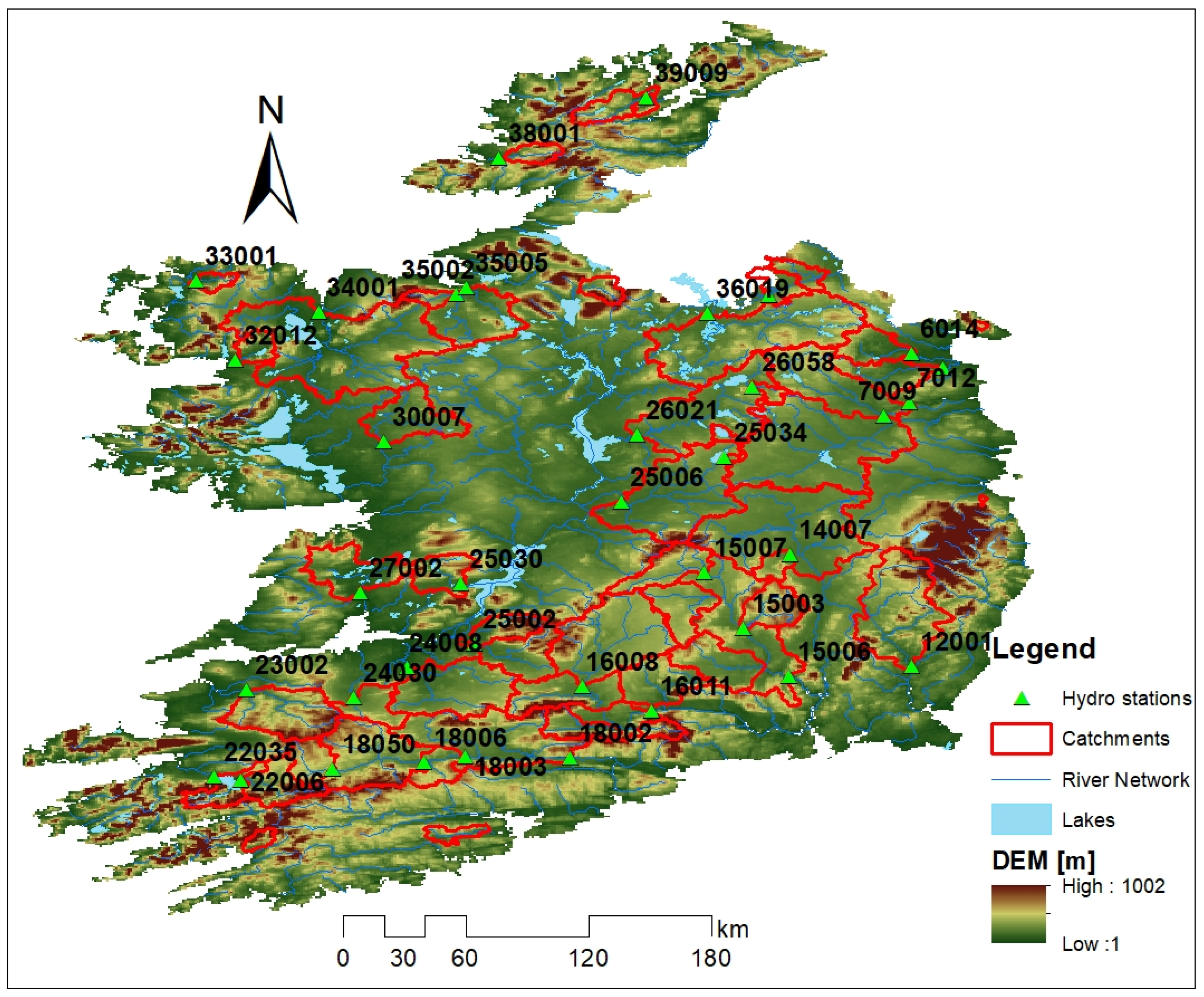
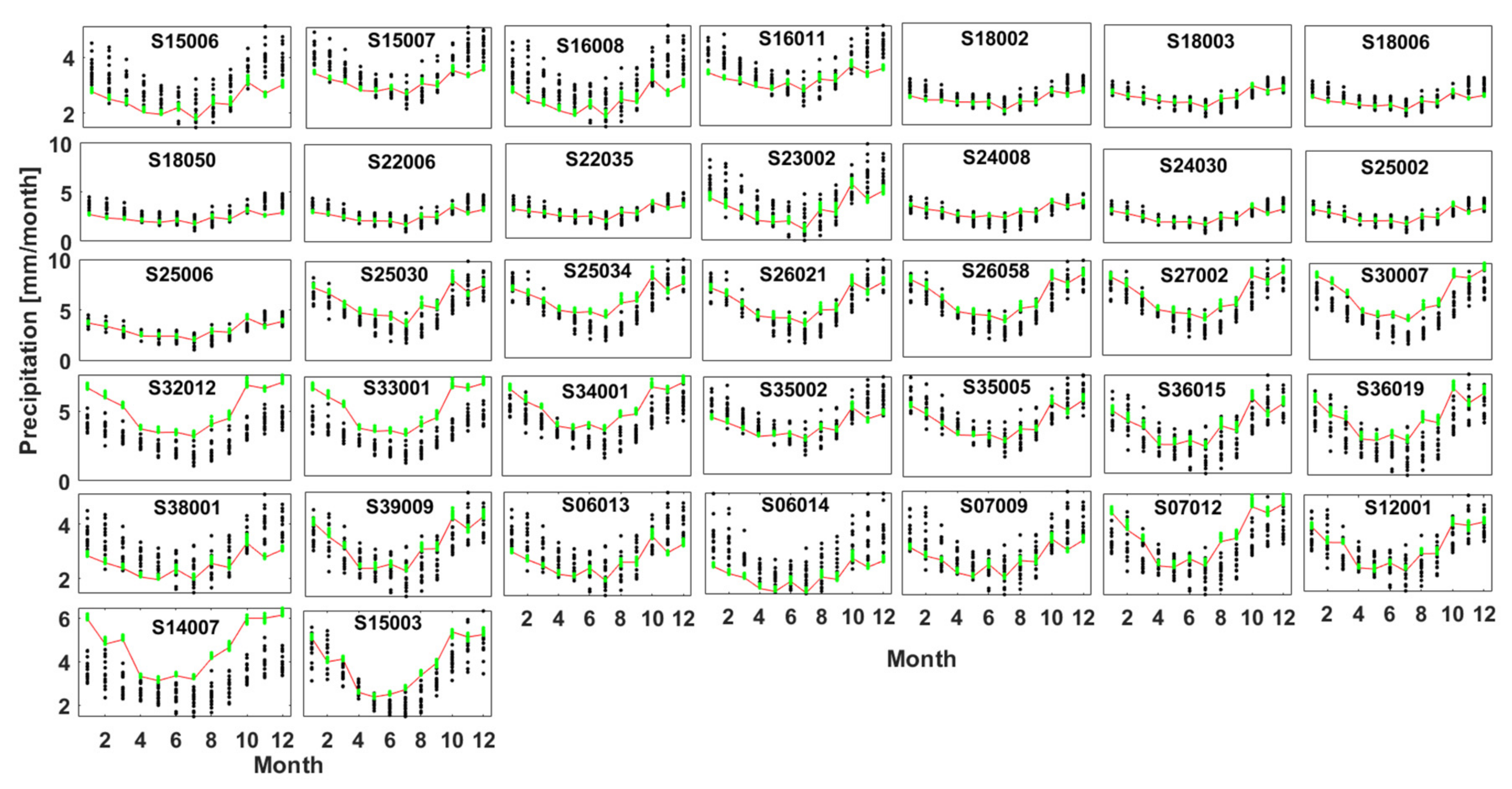

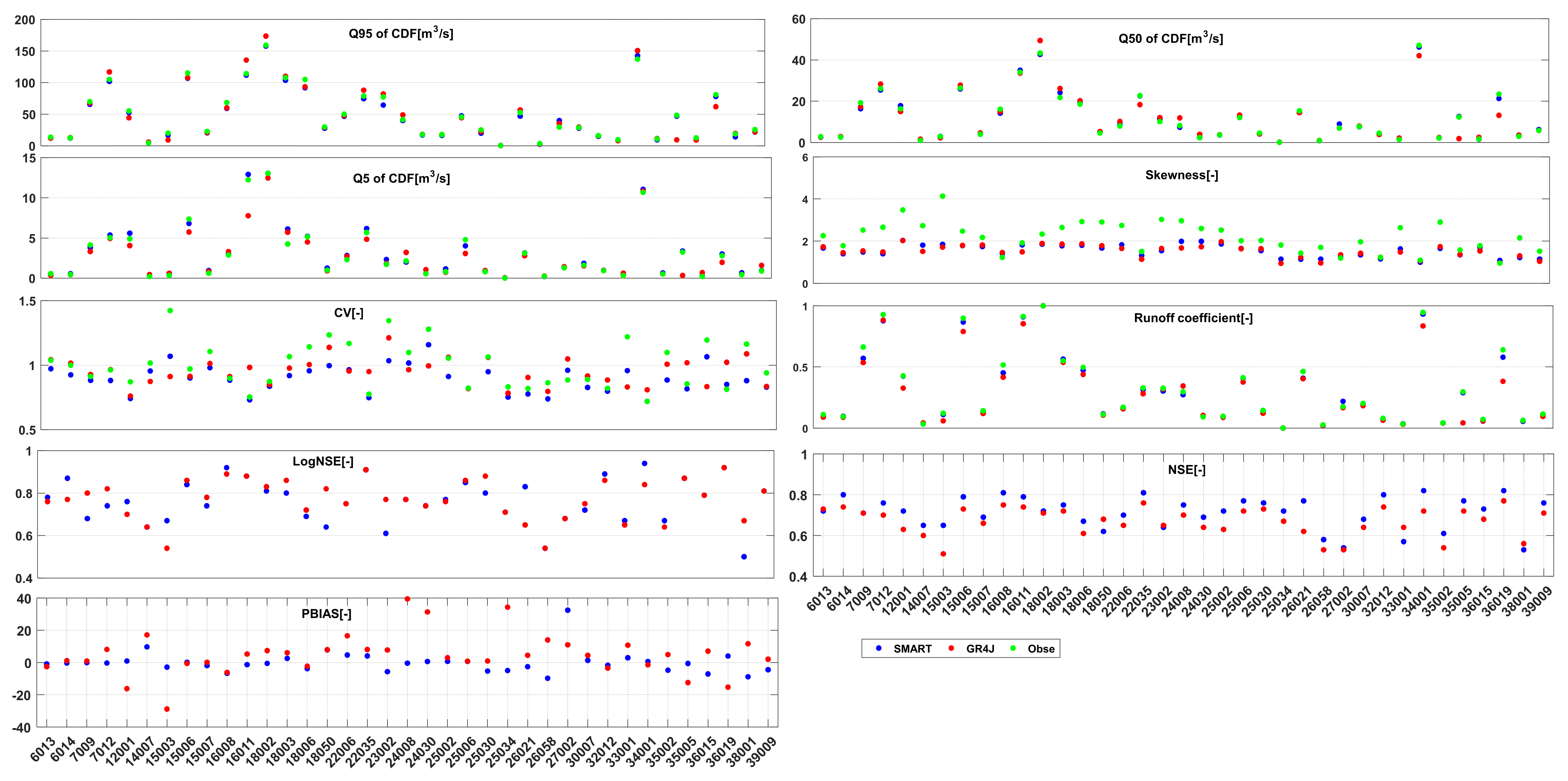
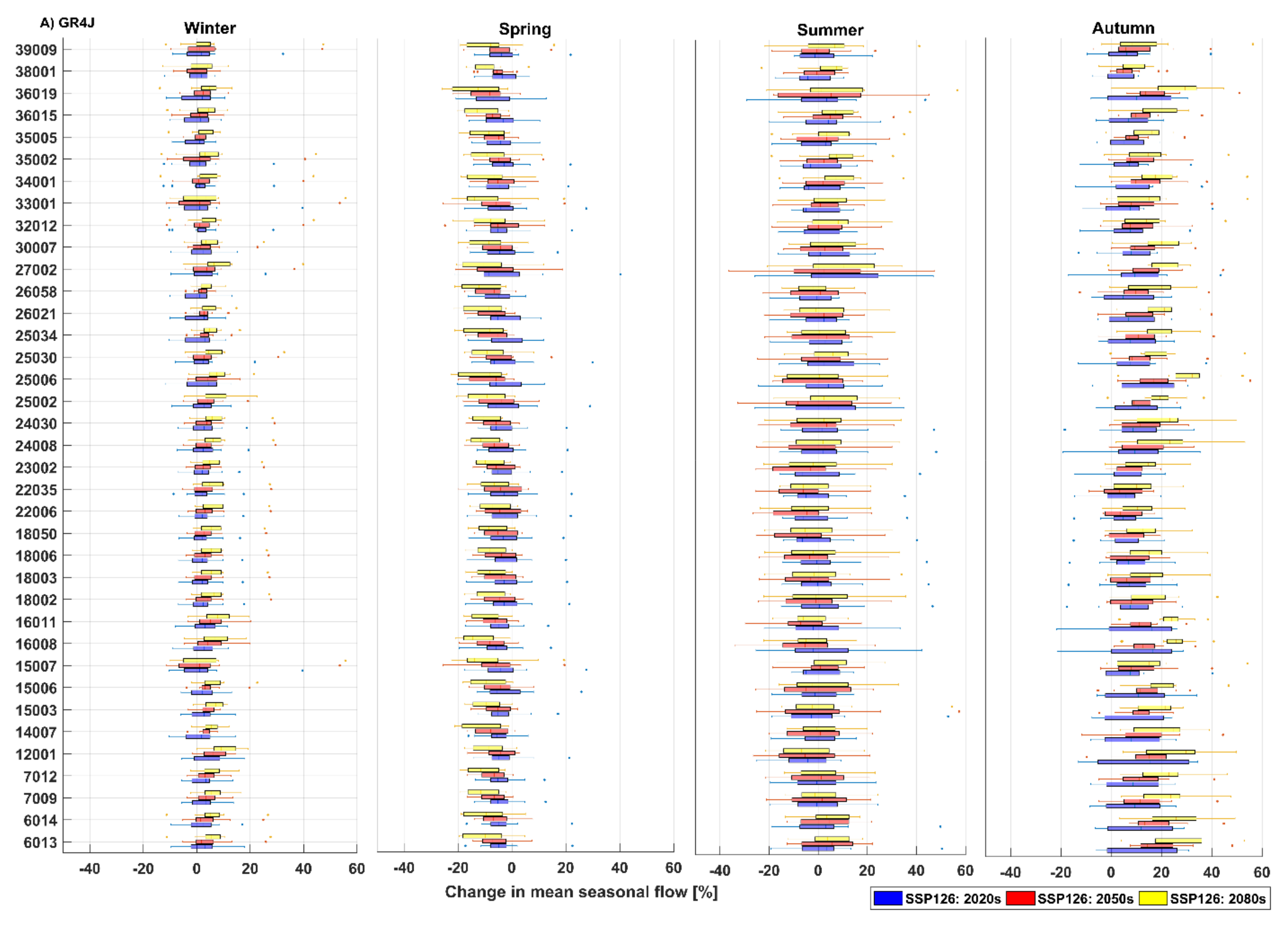
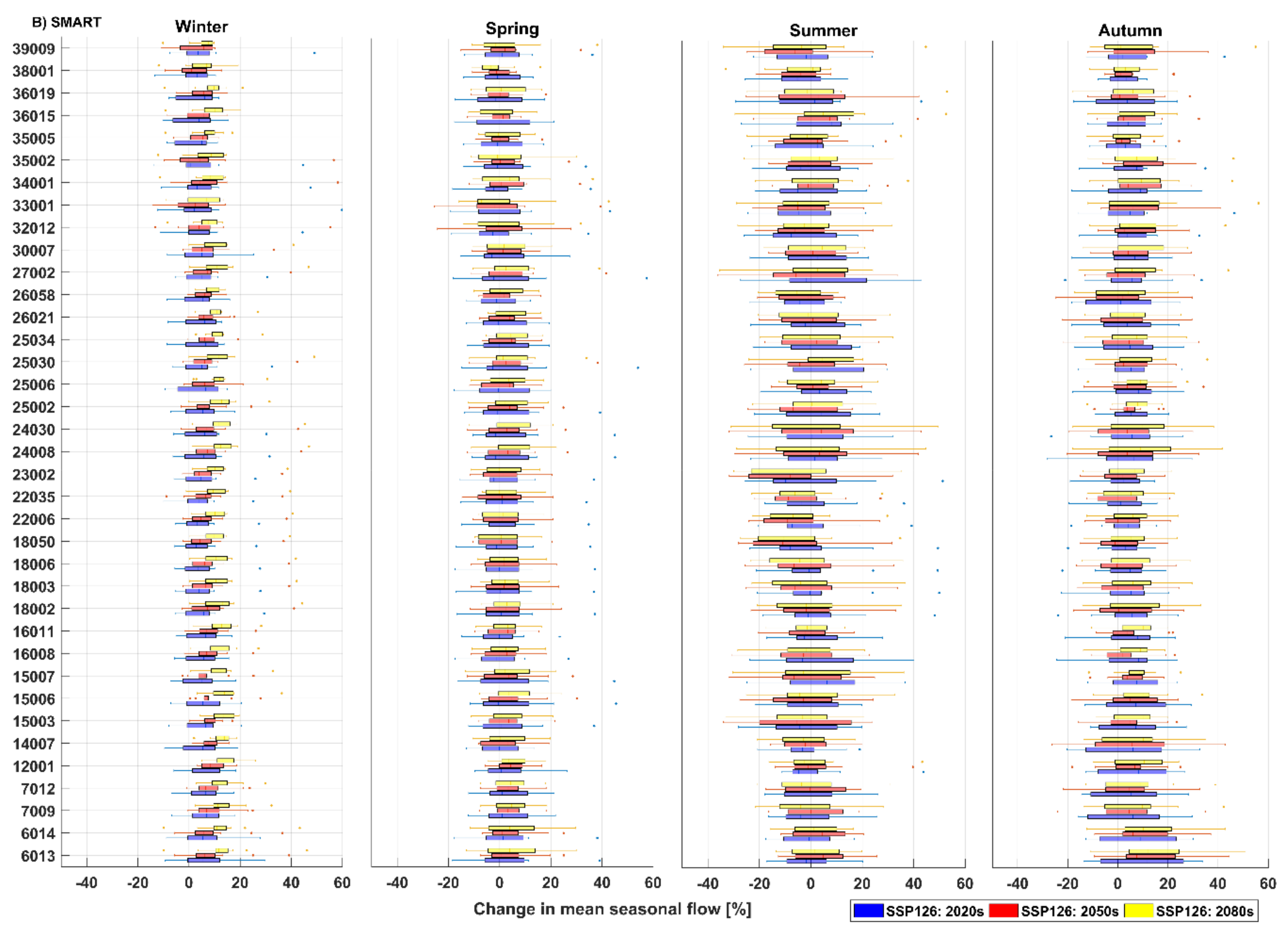
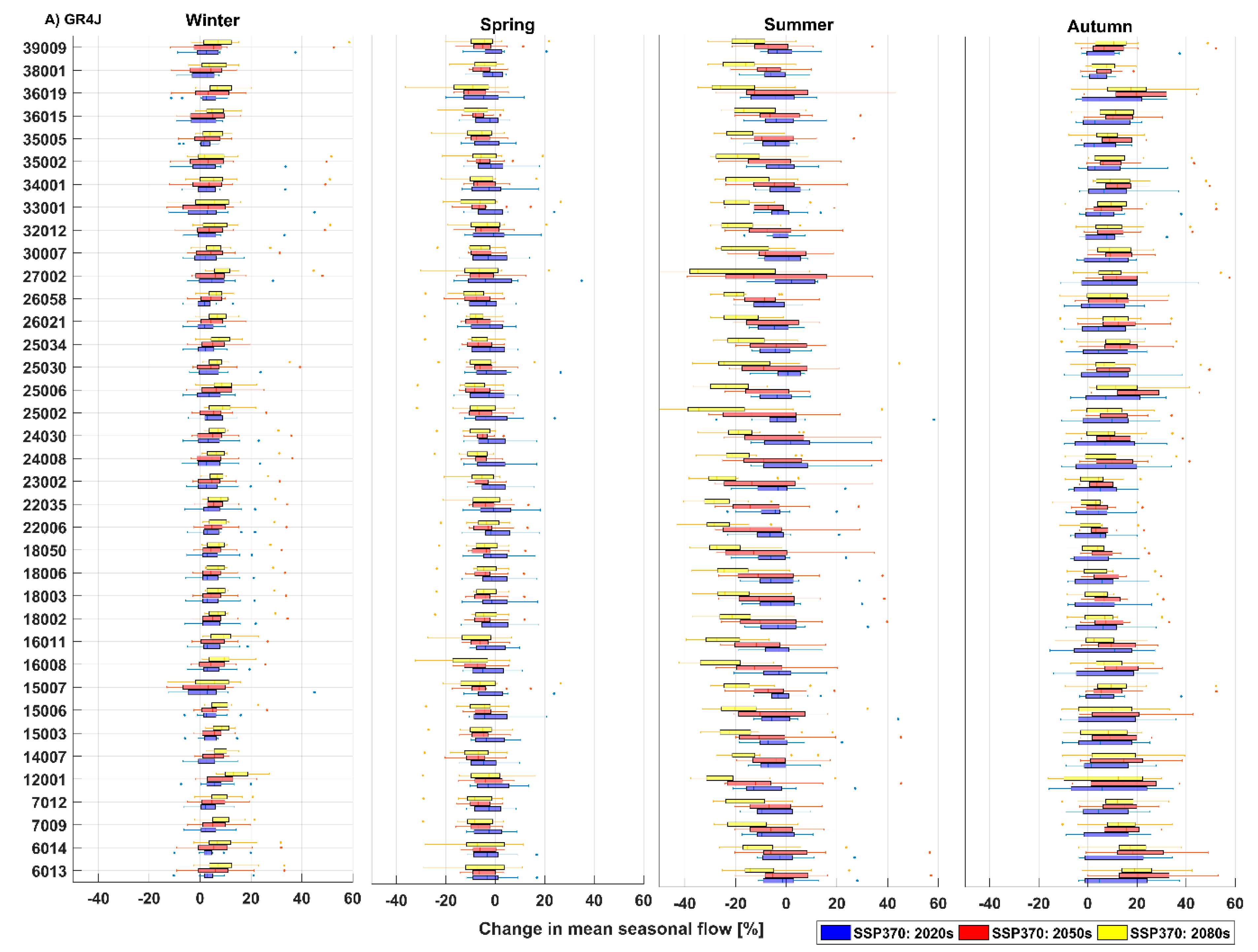
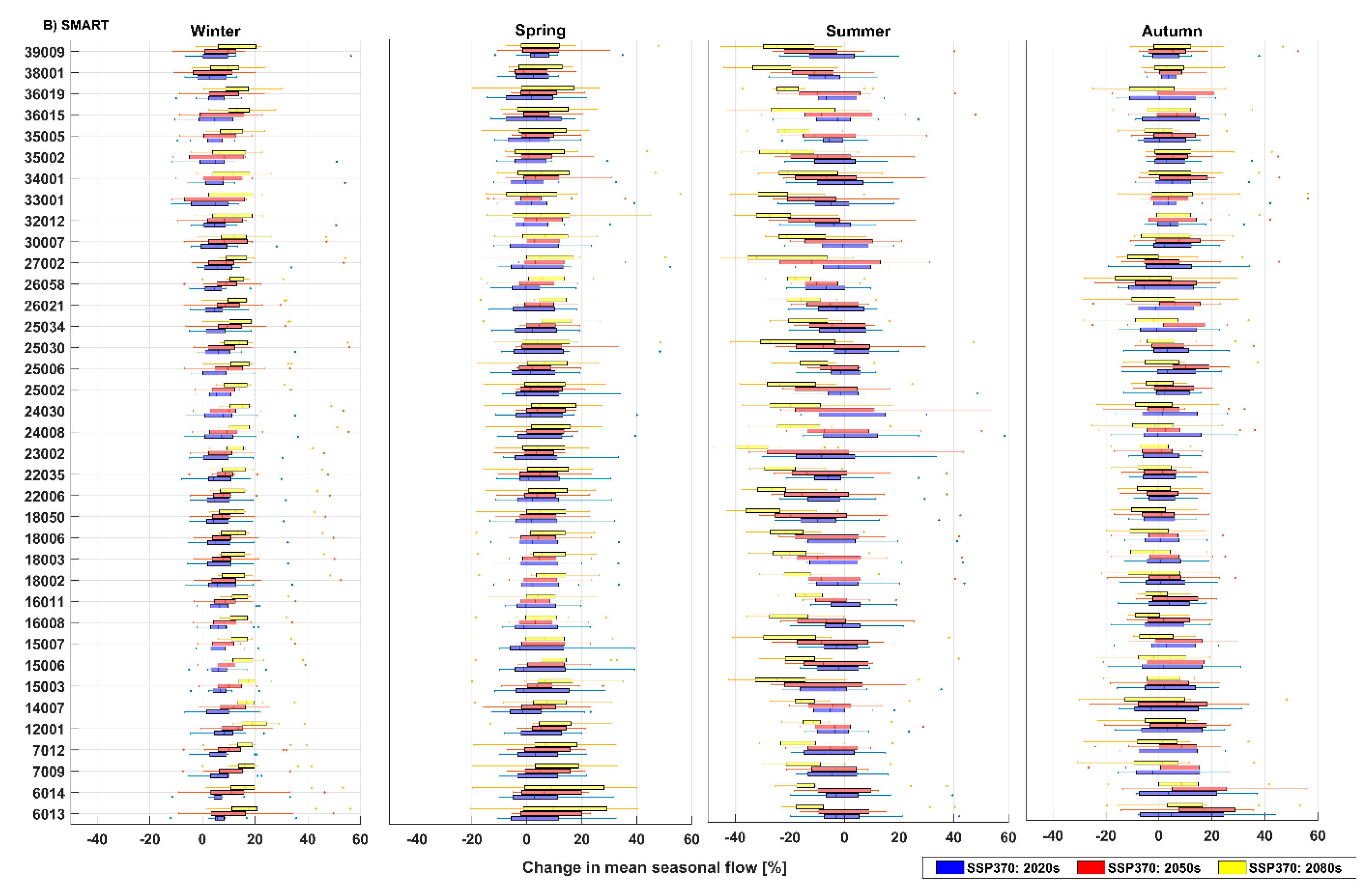


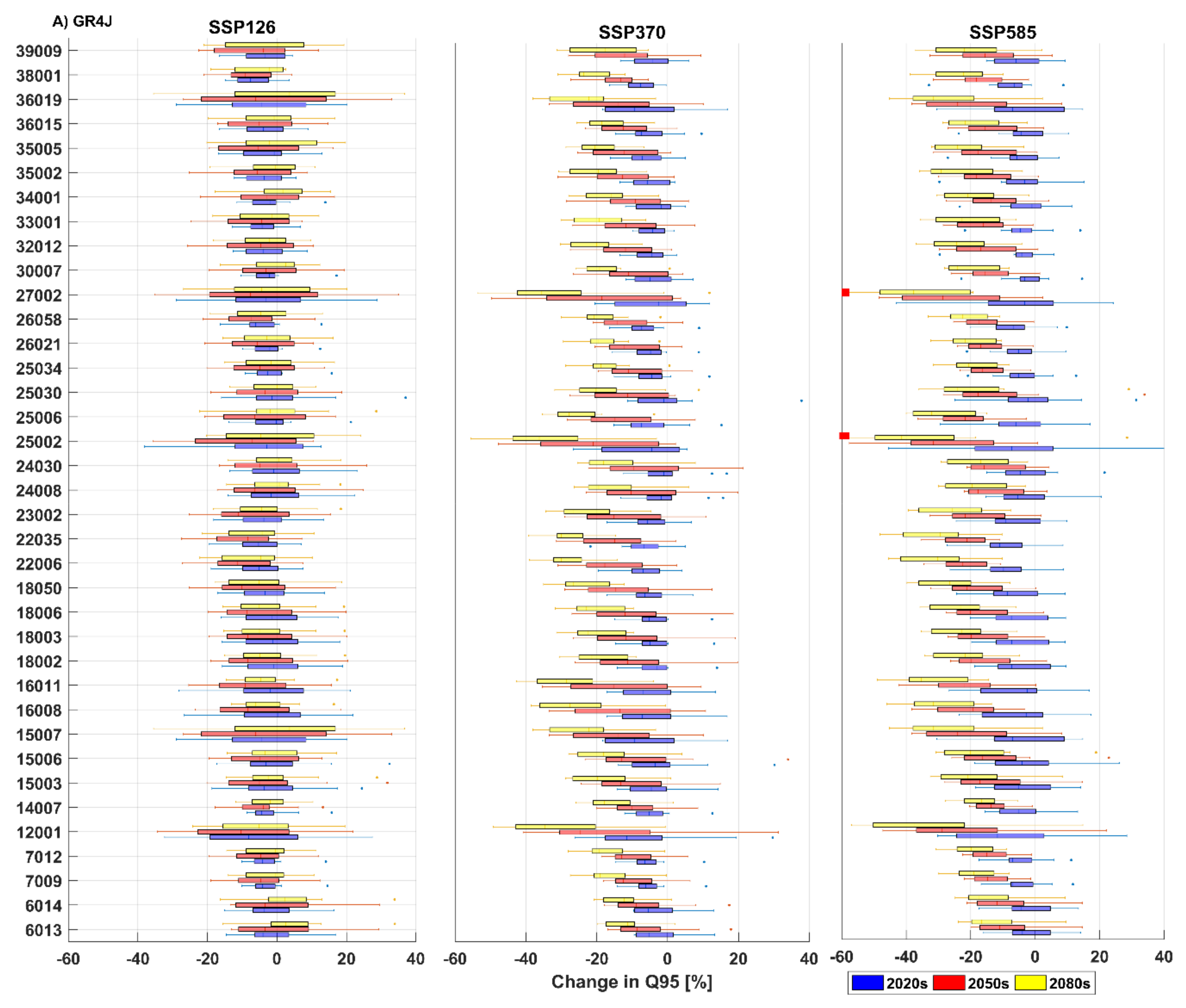



| Code | Institute | Parent Source ID | Institution ID |
|---|---|---|---|
| * CM1 | Commonwealth Scientific and Industrial Research Organisation, Australia | ACCESS-CM2 | CSIRO |
| * CM2 | Met Office Hadley Centre, UK | UKESM1-0-LL | MOHC |
| CM3 | Beijing Climate Center, China | BCC-CSM2-MR | BCC |
| CM4 | Global Fluid Dynamics Laboratory, USA | GFDL | NOAA-GFDL |
| CM5 | European: EC-EARTH consortium | EC-Earth | EC-EARTH consortium |
| * CM6 | National Center for Atmospheric Research, USA | CESM2 | NCAR |
| * CM7 | Met Office Hadley Centre, UK | HadGEM3-GC31-LL | MOHC |
| CM8 | JAMSTEC, AORI, NIES, and R-CCS, Japan | MIROC6 | MIROC |
| CM9 | Max Planck Institute for Meteorology, Germany | MPI-ESM1-2-HR | MPI-M |
| CM10 | Meteorological Research Institute, Japan | MRI-ESM2-0 | MRI |
| CM11 | NorESM Climate modeling Consortium, Norway | NorESM2-LM | NCC |
| * CM12 | Nanjing University of Information Science and Technology, China | NESM3 | NUIST |
| Model | Parameter | Description | Lower | Upper | Unit |
|---|---|---|---|---|---|
| GR4J | X1 | Capacity of the soil store production | 2.59 | 582.75 | mm |
| X2 | Water exchange coefficient | −4.02 | 4.81 | mm/d | |
| X3 | Capacity of the routing store | 18.24 | 500 | mm | |
| X4 | Time parameter for unit hydrographs | 0.12 | 5 | d | |
| SMART | T | Areal Rainfall Correction coefficient | 0.9 | 1.1 | (/) |
| C | Evaporation decay parameter | 0 | 1 | (/) | |
| H | Quick runoff coefficient | 0 | 0.3 | (/) | |
| D | Drain flow parameter | 0 | 1 | (/) | |
| S | Soil outflow coefficient | 0 | 0.013 | (/) | |
| Z | Effective soil depth | 15 | 150 | mm | |
| SK | Surface routing parameter | 1 | 240 | d | |
| FK | Interflow routing parameter | 48 | 1440 | d | |
| GK | Groundwater routing parameter | 1200 | 4800 | d | |
| RK | River routing parameter | 1 | 96 | d |
Publisher’s Note: MDPI stays neutral with regard to jurisdictional claims in published maps and institutional affiliations. |
© 2022 by the authors. Licensee MDPI, Basel, Switzerland. This article is an open access article distributed under the terms and conditions of the Creative Commons Attribution (CC BY) license (https://creativecommons.org/licenses/by/4.0/).
Share and Cite
Meresa, H.; Donegan, S.; Golian, S.; Murphy, C. Simulated Changes in Seasonal and Low Flows with Climate Change for Irish Catchments. Water 2022, 14, 1556. https://doi.org/10.3390/w14101556
Meresa H, Donegan S, Golian S, Murphy C. Simulated Changes in Seasonal and Low Flows with Climate Change for Irish Catchments. Water. 2022; 14(10):1556. https://doi.org/10.3390/w14101556
Chicago/Turabian StyleMeresa, Hadush, Seán Donegan, Saeed Golian, and Conor Murphy. 2022. "Simulated Changes in Seasonal and Low Flows with Climate Change for Irish Catchments" Water 14, no. 10: 1556. https://doi.org/10.3390/w14101556






